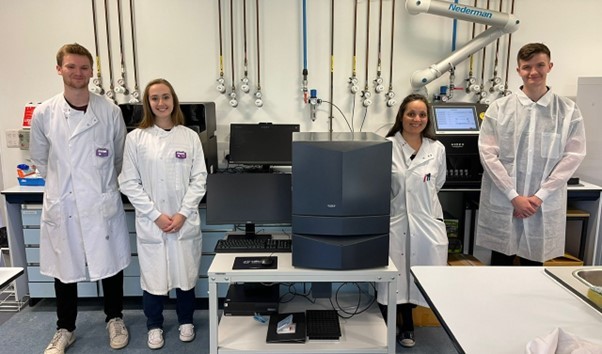Quantifying radiolabelled CECs using Hidex instruments
22nd January 2024

The ARIEL team at the University of Surrey with Dr. Al Sid Cheikh (second from right) with Product Specialist Luke Brammer (far right).
The University of Surrey has been researching the fate of contaminants of emerging concerns to understand the long-term effects of nanoplastics in the environment
Hidex instruments are being used by the University of Surrey’s Applied-RadioIsotope and Environmental Laboratory (ARIEL) to research and understand the fate and behaviour of contaminants of emerging concerns (CECs). CECs are pollutants such as domestic chemicals, pharmaceuticals, and agricultural runoff detected in bodies of water.
Lead by Dr. Maya Al Sid Cheikh, the research is specifically concerned with nanoplastics, which are ubiquitous in domestic products and discharged in large quantities from industrial processes and can have devastating impacts on biodiversity, ecosystems, and food chains. Maya and her team at ARIEL are trying to trace these from origin through to dispersion in the environment and living organizms to understand how long they persist.
One of the methods Maya and her team aim to do this through is by 14C radiolabeling, and eventually 3H. To assist in the preparation and analysis of her samples, Maya uses:
Quantifying CECs in organic compound matrices
Explaining her workflow using the Hidex instruments, Maya said, “I have been radiolabelling CECs to track and quantify them in organic compound matrices, such as soil and seawater. Matrices containing the radiolabelled CECs are combusted using the 600 OX before being counted on the 300 SL. This allows me to see how many nanoplastics have been retained in the matrices by counting the Carbon-14 trapped in the scintillation cocktail.”
Besides nanoplastics, another CEC that ARIEL radiolabels is TBT (tributyltin), a biocide used as an antifouling coating for ship hulls that poisons barnacles and algae. Although banned since 2008, it is still a persistent contaminant in marinas and waterways.
Achieving a faster workflow with Hidex
“The 600 OX is one of the best ways of preparing samples on the 300 SL. I’ve used older models of oxidizers before, which were limited to one sample. I really like that I can put six samples at once into the 600 OX and achieve higher throughput.
“Because the radiolabelled CECs are so small and have such low activity, the 300 SL Super Low Level is really good at picking up residual radioactivity and has additional lead shielding to reduce background radiation.
“The footprint of each Hidex instrument is small enough that when you are more limited on lab space, it is much easier to fit the instruments into a convenient working arrangement.”
Find out more
You can learn more about the Hidex range of instruments by clicking the button below to speak to a product specialist directly.